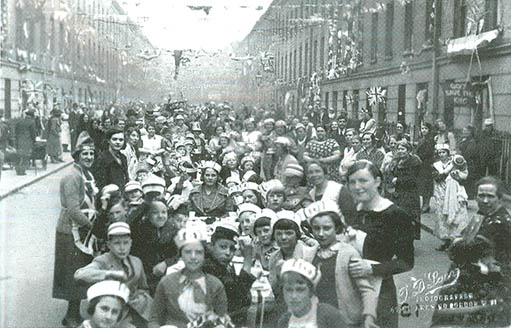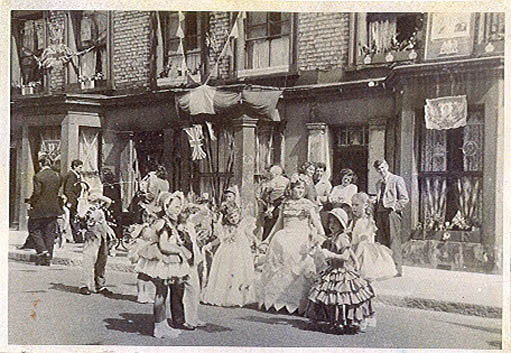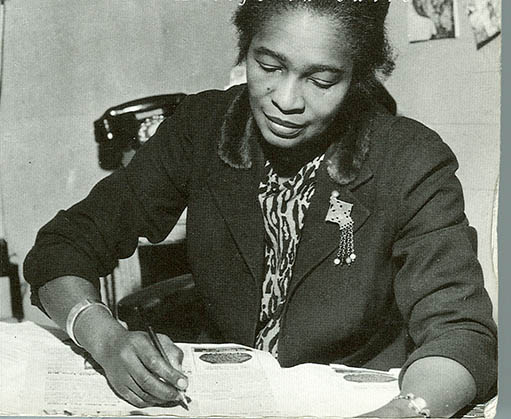PORTOBELLO
CARNIVAL FILM FESTIVAL 2008
1
Portobello Carnival Film Festival 2008
2 Lord
Holland’s Slavery to Work Scheme
3 The
Notting Dale Gypsies
4 Portobello
Busker Parades
5 1966
London Free School Michaelmas Fayre
6 1968
Interzone International Times Fair
7 1977
Two Sevens Clash Punky Reggae Party
8 1983/4
Aswad Live And Direct Carnival
9 1995
Hugh Grant Mas and Mayhem
PART 4
Portobello
Busker Parades
Between the wars Portobello
Road was noted for busker parades and impromptu Bedknobs
and Broomsticks-style carnivals. As recalled in Portobello:
Its People, Its Past, Its Present, a busker group featuring
saxophone, trumpet, cornet and banjo players had a street
parade from the Sun in Splendour pub up to the Gas Works.
There was also a pianist and singer in the back of a
van, a concertina player touring the pubs, and ‘Silly
Henry’, an early breakdancer who’s sound-system
consisted of a gramophone in a pram. The streets of
Ladbroke Grove were also the scene of regular Catholic
processions.

Wilsham Street George VI Coronation Street Party 1936
1941 Bedknobs and Broomsticks Carnival
The Disneyland Carnival scene in Bedknobs and
Broomsticks, set in 1941, features Cockney, Scottish
and Asian turns and a West Indian steel band. It is
possible that West Indian servicemen would have been
on Portobello during the war, but steel bands were only
just coming into existence in the West Indies; using
US army oil drums to get round British colonial laws
banning the beating of African drums.

Rillington Place Elizabeth II Coronation Street Party
1953
1958 Rock’n’Roll Fascist Carnival
(Link to 58 Remembered – 50 Years On and Historytalk)
Over the August bank holiday weekend of 1958,
a local mob reinforced by Teddy boys indulged in a dictionary
definition Carnival of ‘riotous revelry: reckless
indulgence in something’, if not much bloodshed
then plenty of window smashing, spurred on by fascists
in an echo of the Nazi Kristallnacht 20 years earlier.
In Beyond the Mother Country, Edward Pilkington calls
Notting Hill during the riots ‘a looking-glass
world’, in which everyday objects like milk-bottles,
dustbin-lids and car tyres were transformed into ammunition,
shields and barricades; like the battle of Portobello
Road, without guns or much serious injury, in GK Chesterton’s
The Napoleon of Notting Hill.
The anti-apartheid bishop Trevor Huddleston concluded
on the riot, when he was based in Holland Park: ‘If
it should lead, as it still may, to a radical searching
of the conscience on the part of ordinary citizens,
then much good will have come out of evil.’ Like
the Gordon riots of 1780, which started anti-catholic
and ended up proto-communist, the 1958 Notting Hill
riot can be seen in a positive light, dispelling the
mother country myth and creating the reality of multicultural
Britain. United in their resolve to stay put, Jamaicans,
Trinidadians, small islanders, even Barbadians (who
were traditionally police) and Africans came together
to forge a new black British Afro-Caribbean identity.
Ironically, the main inspiration of Notting Hill Carnival
wasn’t old English fairs or Caribbean carnivals,
but the anti-black British riot. By the 50th anniversary
of the arrival of the Empire Windrush, and the 40th
of the riot, in the Windrush book charting ‘the
irresistible rise of multi-racial Britain’, Mike
and Trevor Phillips portrayed 1958 as virtually a positive
rite of passage, a ‘sounding board for popular
discontent’ that brought racial prejudice out
into the open, along with white working class exclusion
from mainstream society. The traditional random reckless
revelry was noted, with black and white children playing
together in the streets between incidents; getting close
to the argument that it doesn’t count as a real
race riot. Colin MacInnes’s vision in Absolute
Beginners of a ‘cheerfully anarchic’ music
hall-style Carnival, with hooray Henrys, debutantes
and hustlers dancing in the rain, was pretty much how
it turned out in the 90s.
The Road Made To Walk on Carnival Day
The 1958 origin of Notting Hill Carnival was
summed up by Darcus Howe, the radical 70s organiser,
in his interview for the Mas and Mayhem Carnival history
project: “Once you live a huge moment of history,
you know exactly how history is made. Once you live
in a big moment, otherwise you think somebody orchestrated
it or somebody started it. If you want to look for somebody
who started Carnival you’ll never find an individual
– that’s out of the question, there is no
entrepreneur or impresario who called it into being.
It looked like we needed it and the road was there and
some guys had some instruments in a pub and that was
it. That was it! I think what was important was the
place because the first Notting Hill riots took place
on August bank holiday, so I don’t think it’s
a coincidence that we had it in Notting Hill. I think
Notting Hill has always been, even before the Carnival
started, explained to me as liberated territory, a place
where you stood up for your rights and where Kelso Cochrane
lost his life. That I can accept quite easily because
the coincidence is too bizarre. It just developed.”
1959 West Indian Gazette Caribbean Carnival
The London Caribbean Carnival was officially
founded in 1959 by Claudia Jones, the Trinidad-born
US civil rights activist who edited the West Indian
Gazette. The first ‘indoors Carnival’ (or
West Indian Gazette Carnival) took place on January
30 1959 at St Pancras Town Hall, Euston. Cleo Laine
topped the bill which included the Mighty Terror singing
the calypso ‘Carnival at St Pancras’. The
nearest the indoors Carnival came to Notting Hill was
the Town Hall on Kensington High Street in 1960. In
April ’59 there was a West Indian steel band on
the first CND march to Aldermaston.

Marcus Garvey Birthday Skiffle Carnival
The Carnival stalwart Baron Baker remembered
a late 50s skiffle-Carnival in St Stephen’s Gardens
on Marcus Garvey’s birthday anniversary; featuring
Totobag (from the Caribbean café at 9 Blenheim
Crescent), King Dick, Gash Boots, Benji and himself,
on bongos, guitar, graters, bottles and boxes; but not
whether it was before or after the riot. This Carnival
tendency, at least, was confirmed by Tommy Farr of the
St Stephen’s Gardens tenants’ association,
who recalled ghetto fabulous West Indians turning up
at the street’s Gigi blues club.
In the early 30s, as Rastafarianism was founded in Jamaica,
Marcus Garvey came to London after the collapse of his
Black Starliner Afro-utopian plans; to reputedly be
one of the first West Indian residents of Powis Square
(formerly known as ‘Little (east) India’).
Marcus Garvey died in west Kensington in 1940 and was
buried at Kensal Green cemetery, for 24 years; then
he was re-interred in Kingston as Jamaica’s first
national hero. After the ’58 riot, his widow Amy
Ashwood-Garvey founded the Association for the Advancement
of Coloured People on Bassett Road, and worked with
the Carnival founder Claudia Jones.
1959 Kelso Cochrane Funeral Procession
On May 17 1959, a West Indian man called Kelso
Cochrane was stabbed to death by a gang of white men
on Southam Street in Kensal. This was when the fascist
leader Oswald Mosley was standing as the Union Movement
candidate for North Kensington in the ’59 election,
and holding street meetings around the area. He subsequently
appeared at the murder scene on Southam Street. But,
rather than start another riot, the killing of Kelso
Cochrane turned the tide against the fascists, and started
Notting Hill Carnival.
As Mosley was blamed for bringing further disgrace on
the area, on June 11 over a thousand black and white
people followed Kelso Cochrane’s funeral cortege,
in what has been described as a proto-Carnival procession,
along Ladbroke Grove to Kensal Green Cemetery. Mike
Phillips called it ‘the great event which ended
the 50s and began the West Indian decade of Notting
Hill.’
1963 Ladbroke Grove I Have A Dream March
In the early 60s the basic ingredients of the
modern Notting Hill Carnival were emerging, though not
necessarily in Notting Hill. On August 31 1963, Claudia
Jones’s diary featured a procession of her Committee
of Afro-Asian Caribbean Organisations, in solidarity
with the Washington Martin Luther King “I have
a dream” march, from Ladbroke Grove station to
the US embassy in Grosvenor Square.
1960s Indoors Carnival
After Claudia Jones’s death, Victor Crichlow
(brother of Frank, of El Rio and Mangrove fame), Scrubbs
and Bynoe took up from where she left off with steel
band dances, at such venues as the Lyceum on the Strand
and Porchester Halls in Bayswater. There was even ‘a
tentative alliance with the gay movement’, as
Darcus Howe put it, at the Coleherne pub in Earl’s
Court where Russell Henderson, Sterling Betancourt,
Vernon Fellows and Nickidee played lunchtime jazz sets.
1964 A Hard Day’s Night Parade
Back in North Kensington the community activist
Rhaune Laslett joined forces with the steel band leader
Selwyn Baptiste to teach children to play the pans at
the Wornington Road adventure playground (now the Venture
Centre) off Golborne Road. But, as far as any evidence
goes, in the years of the media myth first Notting Hill
Carnival, 1964 or ’65, nothing happened. Apart
from, that is, when Ringo Starr went ‘parading’
along All Saints Road, and was joined by the other Beatles
in Notting Dale in A Hard Day’s Night.
5 1966
London Free School Michaelmas Fayre
|





